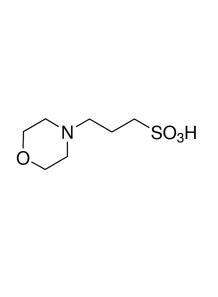MOPS, 3-(N-morpholino)propanesulfonic acid
MOPS, or 3-(N-morpholino)propanesulfonic acid, is a commonly used buffer in biochemical and molecular biology applications

MOPS, or 3-(N-morpholino)propanesulfonic acid, is a commonly used buffer in biochemical and molecular biology applications
MOPS, or 3-(N-morpholino)propanesulfonic acid, is a commonly used buffer in biochemical and molecular biology applications. Here are the key details about MOPS buffer:
1. Chemical Structure and Properties:
- MOPS is a zwitterionic buffer compound, meaning it contains both positively and negatively charged groups within the same molecule.
- It is a white, crystalline powder that is highly soluble in water and other polar solvents.
- MOPS has a pKa value of around 7.2, making it useful for maintaining a neutral pH range.
2. Applications:
- Protein Electrophoresis: MOPS is often used as a buffer component in SDS-PAGE (sodium dodecyl sulfate-polyacrylamide gel electrophoresis) for the separation and analysis of proteins.
- Enzyme Assays: MOPS buffers can help maintain the optimal pH environment for various enzymatic reactions and activity assays.
- Nucleic Acid Manipulation: MOPS can be used as a buffer in applications involving DNA and RNA, such as gel electrophoresis and enzymatic reactions.
- Cell Culture: MOPS may be included in cell culture media to help maintain the desired pH range for cell growth and metabolism.
3. Advantages:
- pH Buffering Range: MOPS is effective in maintaining a pH range of approximately 6.5-7.9, making it suitable for applications that require a neutral environment.
- Compatibility: MOPS is generally considered a biocompatible buffer and is widely used in biological and biochemical applications.
- Solubility: MOPS has good solubility in water and other polar solvents, allowing for easy preparation of buffer solutions.
4. Considerations:
- Temperature Dependence: The pH of MOPS buffer solutions can be affected by temperature, so the pH should be carefully monitored and adjusted as needed.
- Potential Interactions: Like any buffer, MOPS may interact with certain compounds or materials, so its compatibility should be evaluated for specific applications.
Overall, MOPS is a versatile and commonly used buffer in various biochemical and molecular biology applications, particularly in the areas of protein analysis, enzyme assays, and nucleic acid manipulation.
| Mechanism | - |
| Appearance | - |
| Longevity | - |
| Strength | - |
| Storage | - |
| Shelf Life | - |
| Allergen(s) | - |
| Dosage (Range) | - |
| Recommended Dosage | - |
| Dosage (Per Day) | - |
| Recommended Dosage (Per Day) | - |
| Mix Method | - |
| Heat Resistance | - |
| Stable in pH range | - |
| Solubility | - |
| Product Types | - |
| INCI | - |
Purchase History for
Cart
No products



